| Article ID | Journal | Published Year | Pages | File Type |
|---|---|---|---|---|
| 5631238 | NeuroImage | 2017 | 15 Pages |
â¢We compared visual working memory prior to search versus simple recognition.â¢Lateralized memoranda elicited robust contralateral alpha (8-14 Hz) suppression.â¢Lateralized alpha suppression was stronger when memory was needed for visual search.â¢Pre-stimulus long-range alpha connectivity was similarly modulated by task demands.â¢We find that the alpha-band supports increased top-down control of search templates.
Attention during visual search is thought to be guided by an active visual working memory (VWM) representation of the search target. We tested the hypothesis that a VWM representation used for searching a target among competing information (a “search template”) is distinct from VWM representations used for simple recognition tasks, without competition. We analyzed EEG from 20 human participants while they performed three different VWM-based visual detection tasks. All tasks started with identical lateralized VWM cues, but differed with respect to the presence and nature of competing distractors during the target display at test, where participants performed a simple recognition task without distractors, or visual search in pop-out (distinct) and serial (non-distinct) search displays. Performance was worst for non-distinct search, and best for simple recognition. During the one second delay period between cue and test, we observed robust suppression of EEG dynamics in the alpha (8-14Â Hz) band over parieto-occipital sites contralateral to the relevant VWM item, both in terms of local power as well as interregional phase synchrony within a posterior-parietal network. Importantly, these lateralization dynamics were more strongly expressed prior to search compared to simple recognition. Furthermore, before the VWM cue, alpha phase synchrony between prefrontal and mid-posterior-parietal sites was strongest for non-distinct search, reflecting enhanced anticipatory control prior to VWM encoding. Directional connectivity analyses confirmed this effect to be in an anterior-to-posterior direction. Together, these results provide evidence for frontally mediated top-down control of VWM in preparation of visual search.
